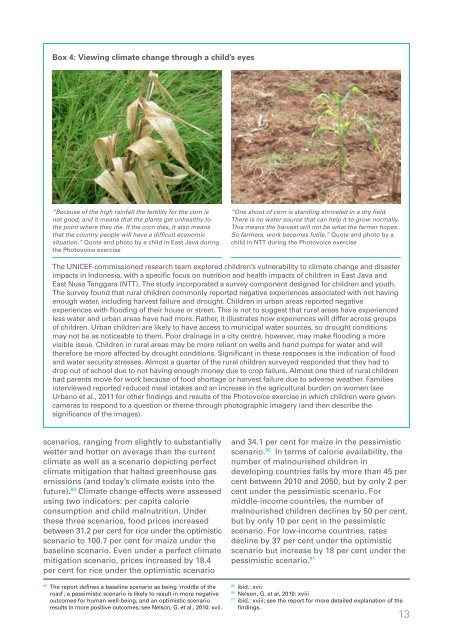Children's Vulnerability to Climate Change and Disaster ... - Unicef UK
Children's Vulnerability to Climate Change and Disaster ... - Unicef UK
Children's Vulnerability to Climate Change and Disaster ... - Unicef UK
Create successful ePaper yourself
Turn your PDF publications into a flip-book with our unique Google optimized e-Paper software.
Box 4: Viewing climate change through a child’s eyes<br />
“Because of the high rainfall the fertility for the corn is<br />
not good, <strong>and</strong> it means that the plants get unhealthy <strong>to</strong><br />
the point where they die. If the corn dies, it also means<br />
that the country people will have a difficult economic<br />
situation.” Quote <strong>and</strong> pho<strong>to</strong> by a child in East Java during<br />
the Pho<strong>to</strong>voice exercise<br />
“One shoot of corn is st<strong>and</strong>ing shriveled in a dry field.<br />
There is no water source that can help it <strong>to</strong> grow normally.<br />
This means the harvest will not be what the farmer hopes.<br />
So farmers. work becomes futile.” Quote <strong>and</strong> pho<strong>to</strong> by a<br />
child in NTT during the Pho<strong>to</strong>voice exercise<br />
The UNICEF-commissioned research team explored children’s vulnerability <strong>to</strong> climate change <strong>and</strong> disaster<br />
impacts in Indonesia, with a specific focus on nutrition <strong>and</strong> health impacts of children in East Java <strong>and</strong><br />
East Nusa Tenggara (NTT). The study incorporated a survey component designed for children <strong>and</strong> youth.<br />
The survey found that rural children commonly reported negative experiences associated with not having<br />
enough water, including harvest failure <strong>and</strong> drought. Children in urban areas reported negative<br />
experiences with flooding of their house or street. This is not <strong>to</strong> suggest that rural areas have experienced<br />
less water <strong>and</strong> urban areas have had more. Rather, it illustrates how experiences will differ across groups<br />
of children. Urban children are likely <strong>to</strong> have access <strong>to</strong> municipal water sources, so drought conditions<br />
may not be as noticeable <strong>to</strong> them. Poor drainage in a city centre, however, may make flooding a more<br />
visible issue. Children in rural areas may be more reliant on wells <strong>and</strong> h<strong>and</strong> pumps for water <strong>and</strong> will<br />
therefore be more affected by drought conditions. Significant in these responses is the indication of food<br />
<strong>and</strong> water security stresses. Almost a quarter of the rural children surveyed responded that they had <strong>to</strong><br />
drop out of school due <strong>to</strong> not having enough money due <strong>to</strong> crop failure. Almost one third of rural children<br />
had parents move for work because of food shortage or harvest failure due <strong>to</strong> adverse weather. Families<br />
interviewed reported reduced meal intakes <strong>and</strong> an increase in the agricultural burden on women (see<br />
Urbano et al., 2011 for other findings <strong>and</strong> results of the Pho<strong>to</strong>voice exercise in which children were given<br />
cameras <strong>to</strong> respond <strong>to</strong> a question or theme through pho<strong>to</strong>graphic imagery (<strong>and</strong> then describe the<br />
significance of the images).<br />
scenarios, ranging from slightly <strong>to</strong> substantially<br />
wetter <strong>and</strong> hotter on average than the current<br />
climate as well as a scenario depicting perfect<br />
climate mitigation that halted greenhouse gas<br />
emissions (<strong>and</strong> <strong>to</strong>day’s climate exists in<strong>to</strong> the<br />
future). 89 <strong>Climate</strong> change effects were assessed<br />
using two indica<strong>to</strong>rs: per capita calorie<br />
consumption <strong>and</strong> child malnutrition. Under<br />
these three scenarios, food prices increased<br />
between 31.2 per cent for rice under the optimistic<br />
scenario <strong>to</strong> 100.7 per cent for maize under the<br />
baseline scenario. Even under a perfect climate<br />
mitigation scenario, prices increased by 18.4<br />
per cent for rice under the optimistic scenario<br />
88<br />
The report defines a baseline scenario as being ‘middle of the<br />
road’; a pessimistic scenario is likely <strong>to</strong> result in more negative<br />
outcomes for human well-being; <strong>and</strong> an optimistic scenario<br />
results in more positive outcomes; see Nelson, G. et al., 2010: xvii.<br />
<strong>and</strong> 34.1 per cent for maize in the pessimistic<br />
scenario. 90 In terms of calorie availability, the<br />
number of malnourished children in<br />
developing countries falls by more than 45 per<br />
cent between 2010 <strong>and</strong> 2050, but by only 2 per<br />
cent under the pessimistic scenario. For<br />
middle-income countries, the number of<br />
malnourished children declines by 50 per cent,<br />
but by only 10 per cent in the pessimistic<br />
scenario. For low-income countries, rates<br />
decline by 37 per cent under the optimistic<br />
scenario but increase by 18 per cent under the<br />
pessimistic scenario. 91<br />
89<br />
ibid.: xvii<br />
90<br />
Nelson, G. et al, 2010: xviii<br />
91<br />
ibid.: xviii; see the report for more detailed explanation of the<br />
findings.<br />
13

















